from Scenes From The Atlanta Forest
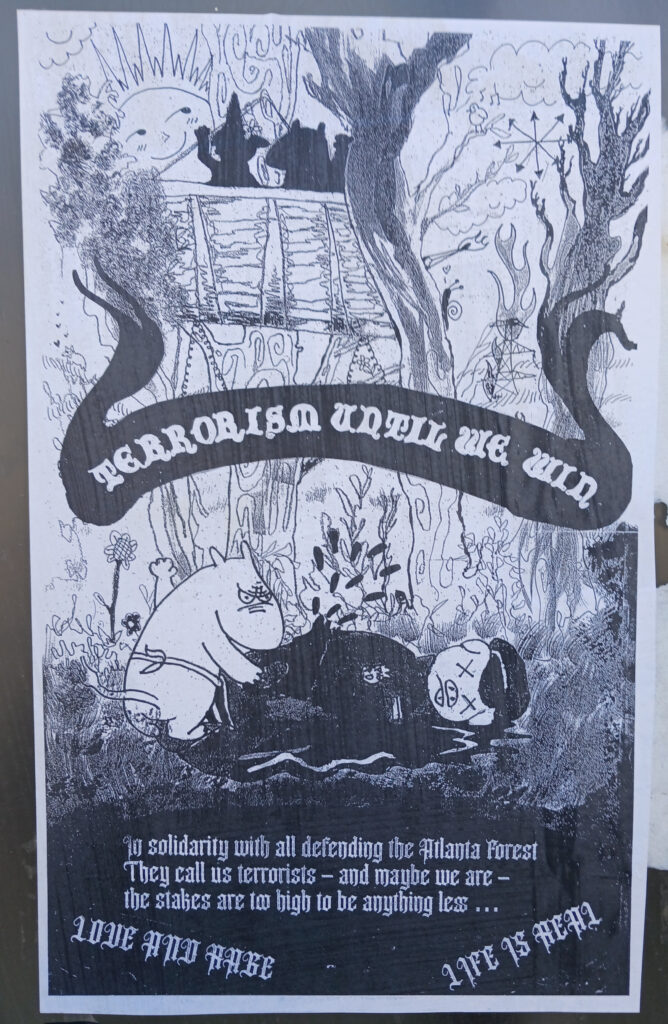
from Iffy Books
Join us Sunday, February 19th at 3:30 p.m. to celebrate the launch of “Fuck a Cellicon Valley,” a zine about a development plan that would displace residents and destroy wild space in the area around Bartam’s North and Bartam’s South. We’ll have snacks and free zines!
Here’s an excerpt:
After we heard rumors about UPenn developing the land around Bartram’s North we did some research and discovered an evil plot. In 2013 a group of economists, developers, city planners, and other villians came up with the Lower Schuylkill Master Plan, a 143 page document envisioning a “21st century industrial district” in Southwest Philly along the Schuykill river corridor. The report details massive development projects to be carried out over 20-25 years. Reading the report in 2023 provided us with some answers and many many questions.
The Master Plan is worth looking over carefully if you are someone who cares about environmental destruction and gentrification. You can find it online at https://www.design.upenn.edu/sites/default/files/LSMP_Small.pdf
The plan breaks up the development projects into three sections. The first is a Logistics Hub, connected to the Philadelphia Airport, whose recent expansion destroyed wetlands to build a cargo facility. We’ve already seen how this has gone down for the FDR meadows. The second is the Energy Corridor in South Philly, where they are currently focused on remediating decades of industrial pollution from oil infrastructure. The remediation is predicted to take years, then they’re going build factories.
The third zone, the Innovation District, is the focus of this zine. Because it is closest to us, because it threatens the places we live in and love. In writing this zine, we hope that other people will look into the master plan and oppose gentrification as they see it manifest in their contexts.
The Innovation District consists of the Pennovation Center and the areas near Bartram’s North and Bartram’s South including some wild lands and spaces. We spend a lot of time in those spaces and despite what developers think, there is already vibrant activity, innovation, and life, we don’t want to see the area get paved over and built up.
…
The Lower Schuylkill Biotech Campus is part of what people at the University of Pennsylvania are calling “Cellicon Valley”. It’s an attempt to brand Philly as the next hi-tech hotspot for pharmaceutical companies and research institutions. Like Silicon Valley, Cellicon Valley is a bad and annoying idea that should never come to fruition. It’s literally a scheme to capture, commodify, and sell us ways to live, by destroying and locking us out of the ways we live.
from Making Worlds Books
IF A TREE FALLS is a documentary looking at the Earth Liberation Front, the radical environmental group that the FBI calls America’s ‘number one domestic terrorist threat.’ The documentary tells the story of Daniel McGowan, an ELF member who faced life in prison for two multi-million dollar arsons against Oregon timber companies. The film examines larger questions about environmentalism, activism, and terrorism.
The police killing of Manuel Teranat / Tortuguita and repression of forest defenders in Atlanta / Cop City this month adds dire weight to our ability to understand ecological defense struggles on their own terms, to understand the elements of repression and state power that seek to discredit, disrupt, and disempower ecodefense movements and separate them from wider bases of popular support. In the process, state violence intensifies and the need for unified support and solidarity is crucial.
This event is fundraising effort in support of ATL Solidarity Fund to help support frontliners in this moment.
Advance registration suggested (free and by donation) to help us host public events safely in a time of ongoing COVID-19 pandemic and other public health stresses on our communities. Click here to register.
from Iffy Books
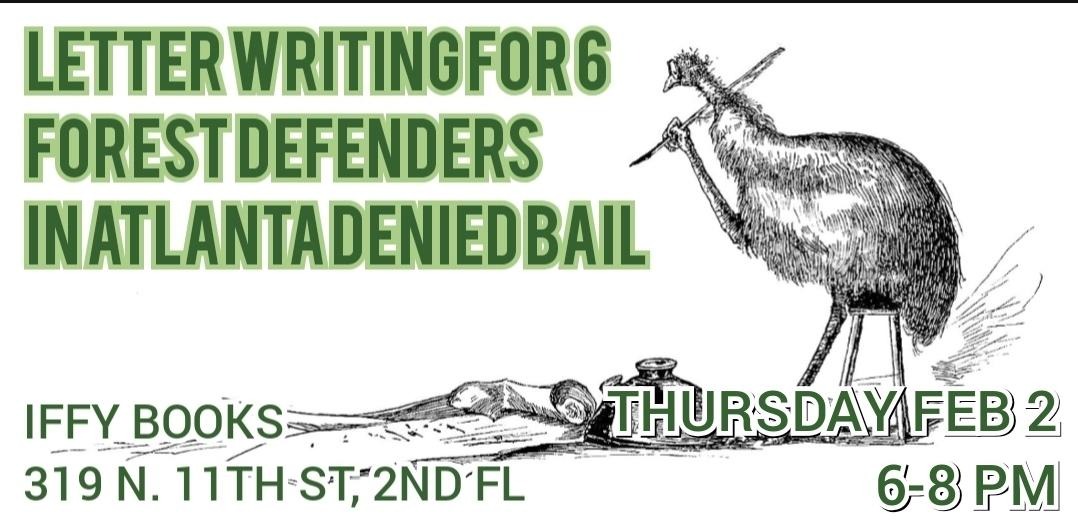
Join us Thursday, February 2nd at 6 p.m. and help write letters to six Atlanta Forest defenders who have been denied bail.
Submission
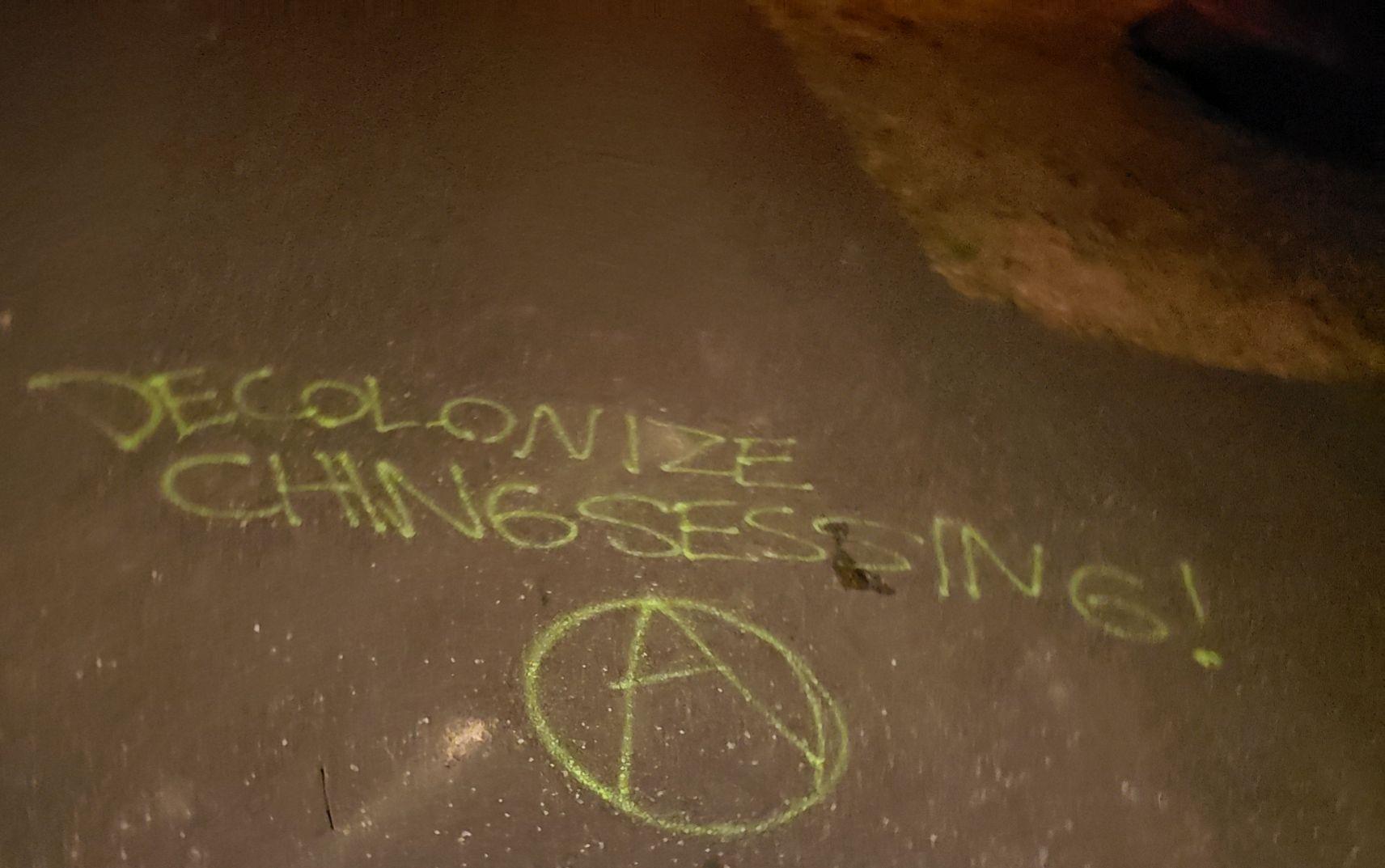

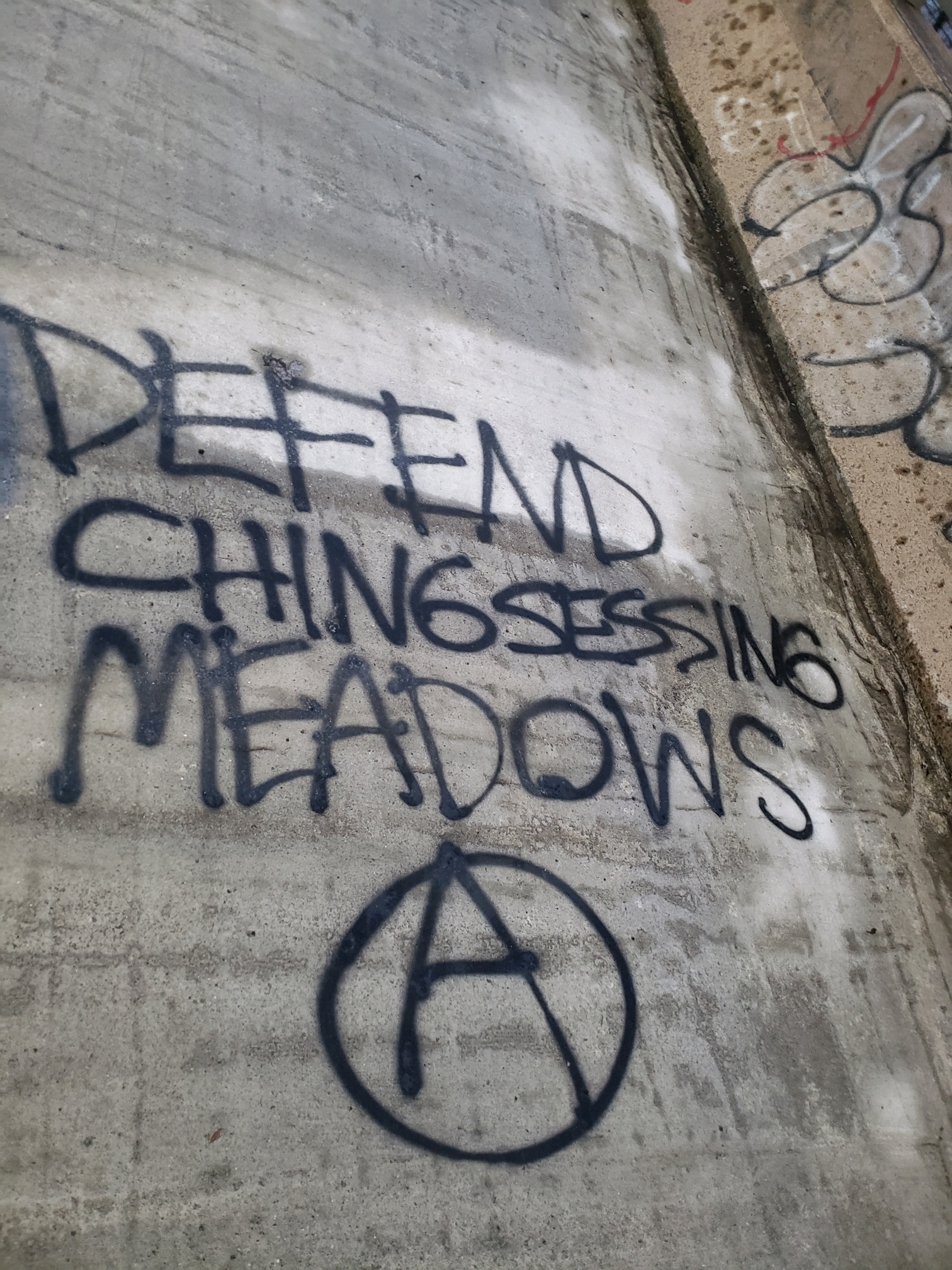
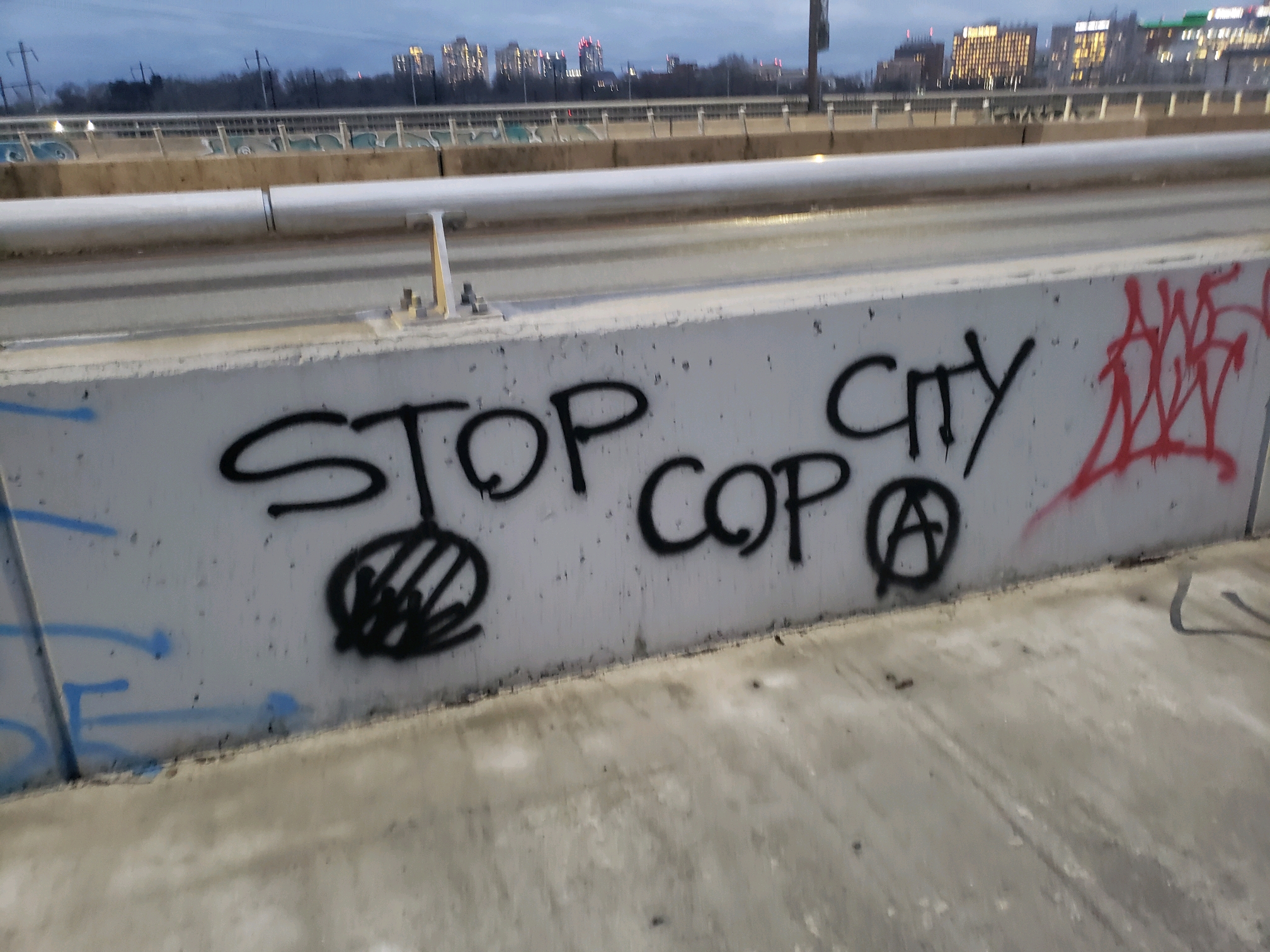
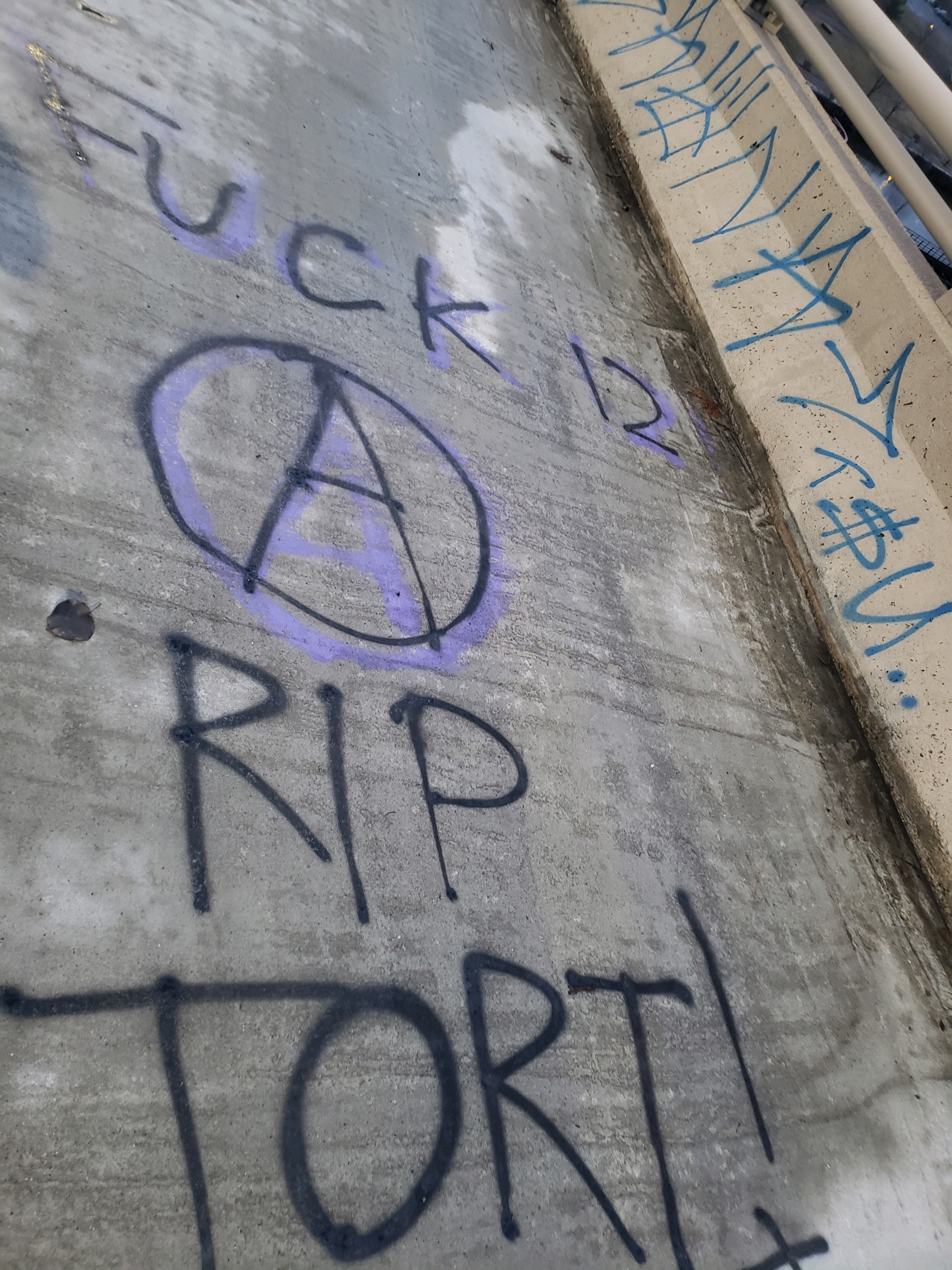

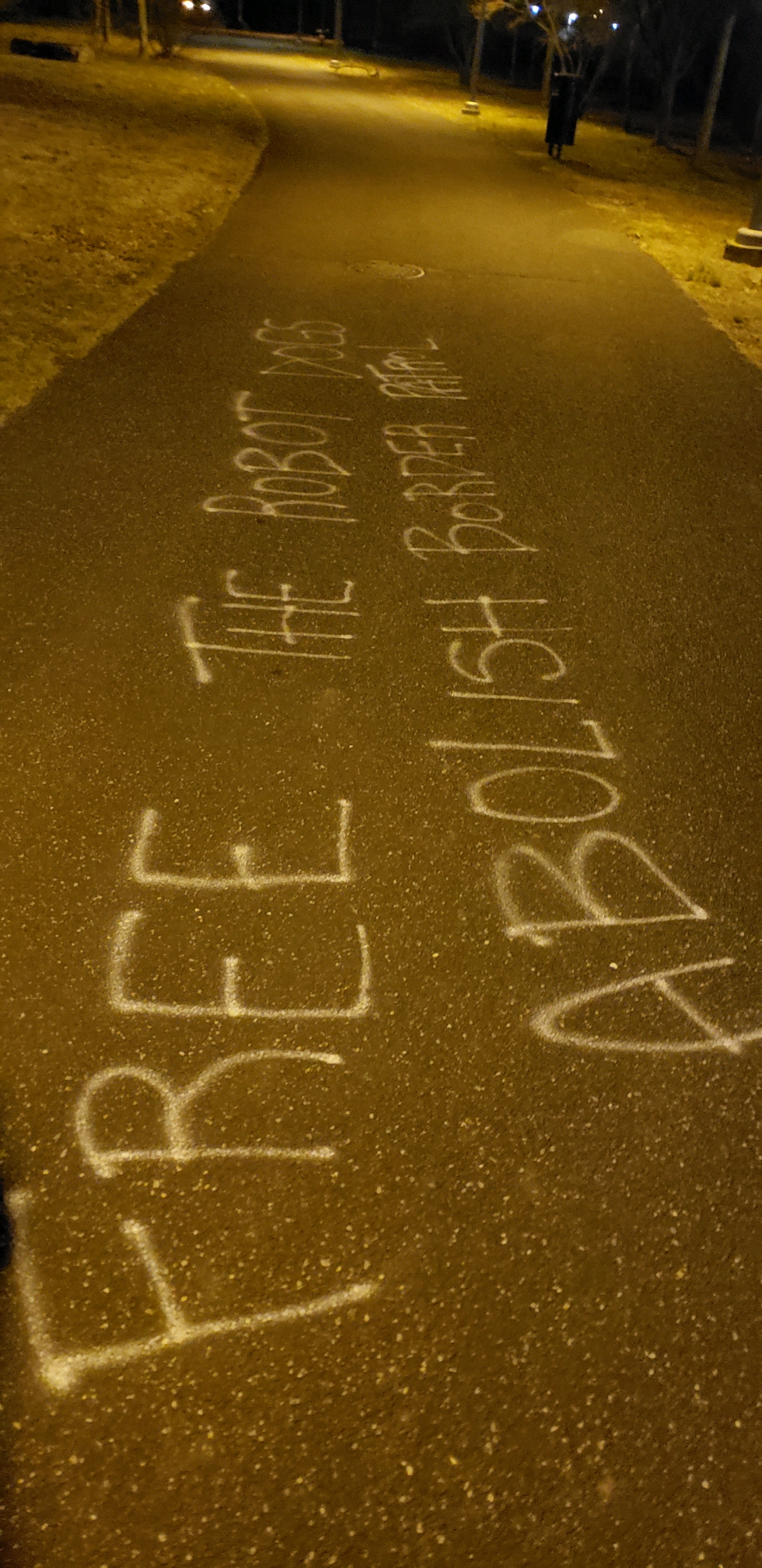
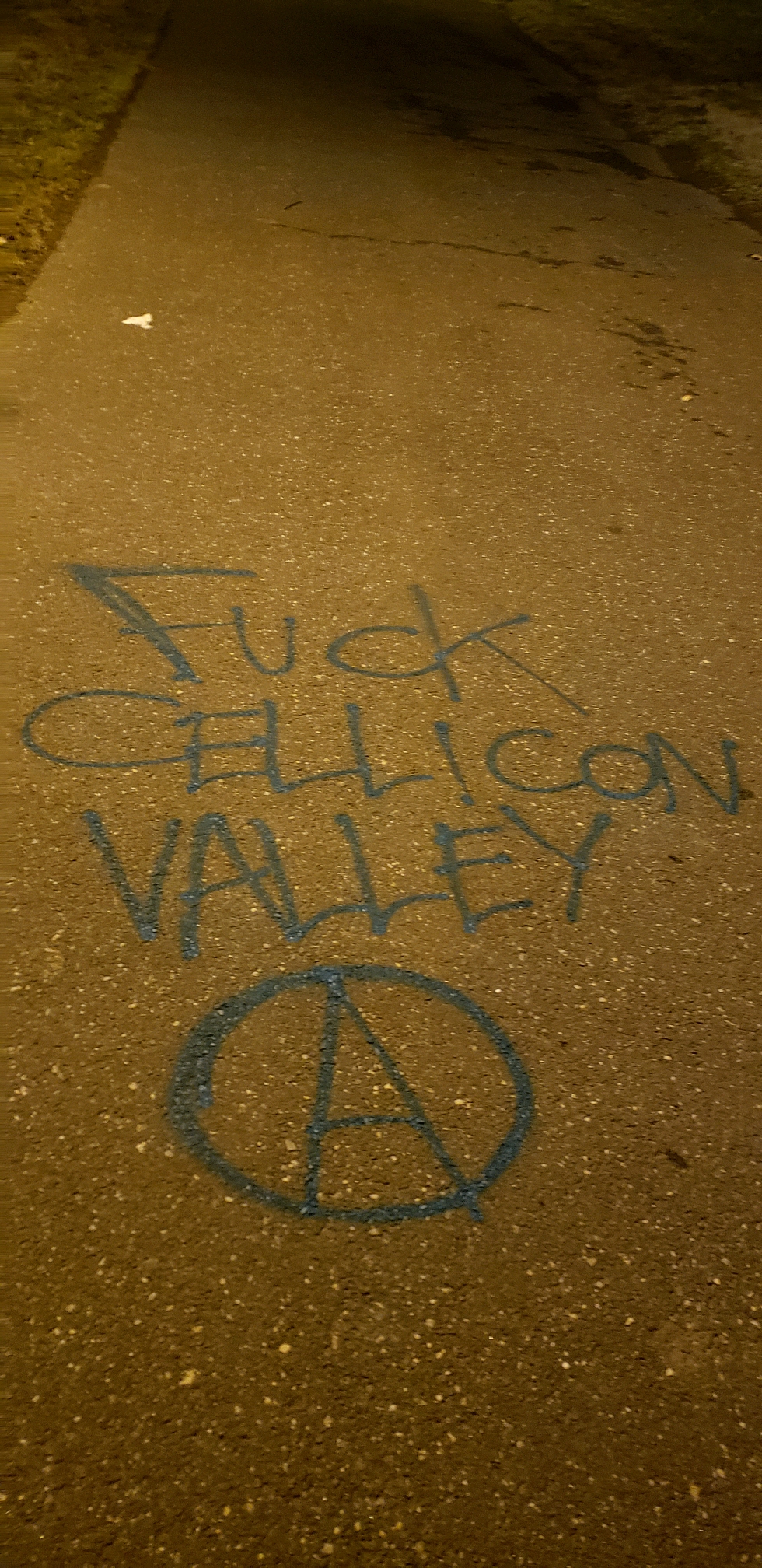
from Unicorn Riot
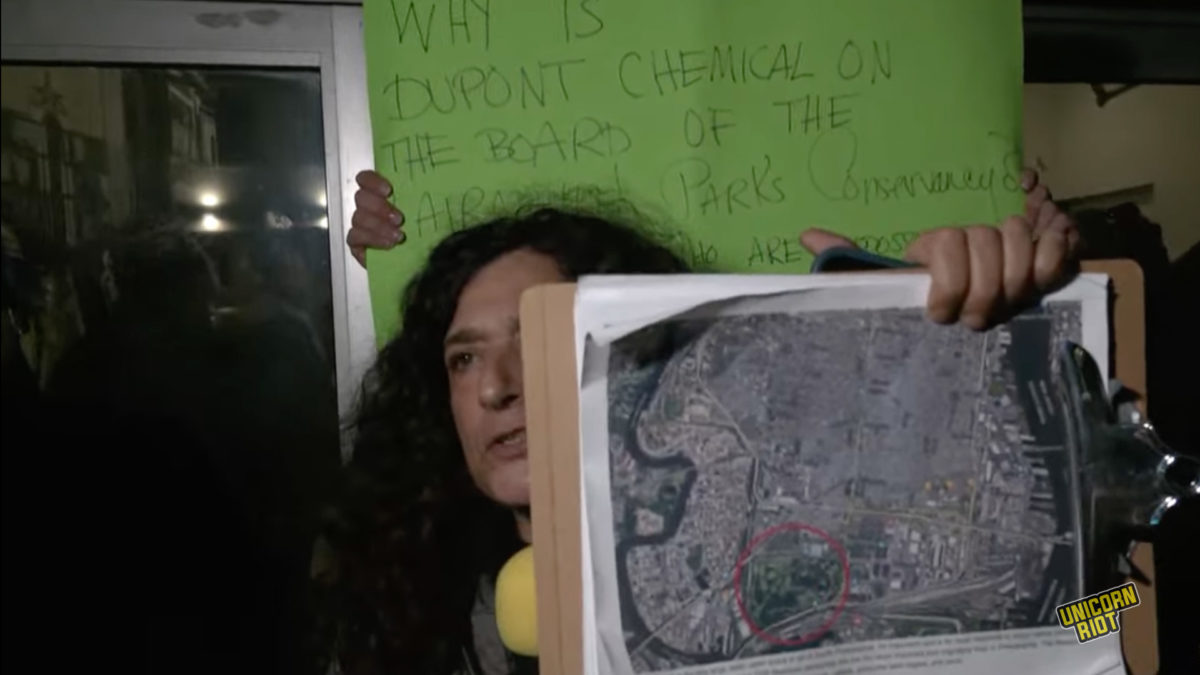
Philadelphia, PA – The FDR Park in South Philly is in the midst of a new redevelopment plan supported by the city and private groups like Fairmount Park Conservancy. Opponents of the plan have dubbed their cause “Save the Meadows,” referencing a wild area that was partly bulldozed late in 2022. The plan’s authors are finally hosting a community event on January 26, 2023, although opponents believe that they will not be allowed to speak inside.
A demonstration outside the Grand Yesha Ballroom in South Philly is highlighting reasons they oppose the plan. An ad-hoc coalition of several groups, under the flag “The People’s Plan for FDR Park,” has pushed local officials to reconsider the plan and preserve more meadows while unlocking often-shuttered sports fields around the city.
Among the main concerns opponents have is that the expansion of the Philadelphia International Airport will remove wetlands near the town of Eastwick, which can thus expect more flooding as climate change intensifies. (The airport’s expansion is a key part of the financing of the FDR Park project.)
Live coverage below:
See our video report from last fall below:
Opposition to the development plan was also an element in a large demonstration and march in November 2022 that highlighted several different, yet related causes in the city.
Submission
On Saturday 1/21 there was a vigil for Tortuguita Manuel Teran. A group of about 40 adults and children placed candles and homemade signs by the turtle in Clark Park.
People spontaneously made speeches about Tortuguita’s death. The speeches touched on people’s experience of them, grief, martyrdom, and continuing to struggle. People called on each other to target cop city’s sponsors and the contractors responsible for building.
After people had been speaking for a while a small group broke off from the vigil. They took the street with banners. Barricades from a nearby construction site were pulled into the street to block cops and traffic. As the march moved graffiti memorializing Tortuguita and against police was tagged. A realty office had its windows smashed.
The rowdy vigil is the first time things have popped off from Clark Park in a while. A few years ago Cark Park was a regular spot for mid sized black bloc demos to start from. We think that this is worthwhile to revisit because it’s a traditionally anarchist neighborhood and there are lots of alleys nearby to easily change in. It’s exciting to see this kind of energy re-emerge in Philly.
Even though Philly is far from Atlanta, Tortuguita’s death has been deeply felt here. We are angry. We are watching. We are acting. Cop city will never be built.
RIP Tortuguita
Neither innocent nor guilty
Neither terrorists nor protesters
Simply anarchists!
A warm embrace to those arrested in Atlanta, Seattle and everywhere else
Death to civilization
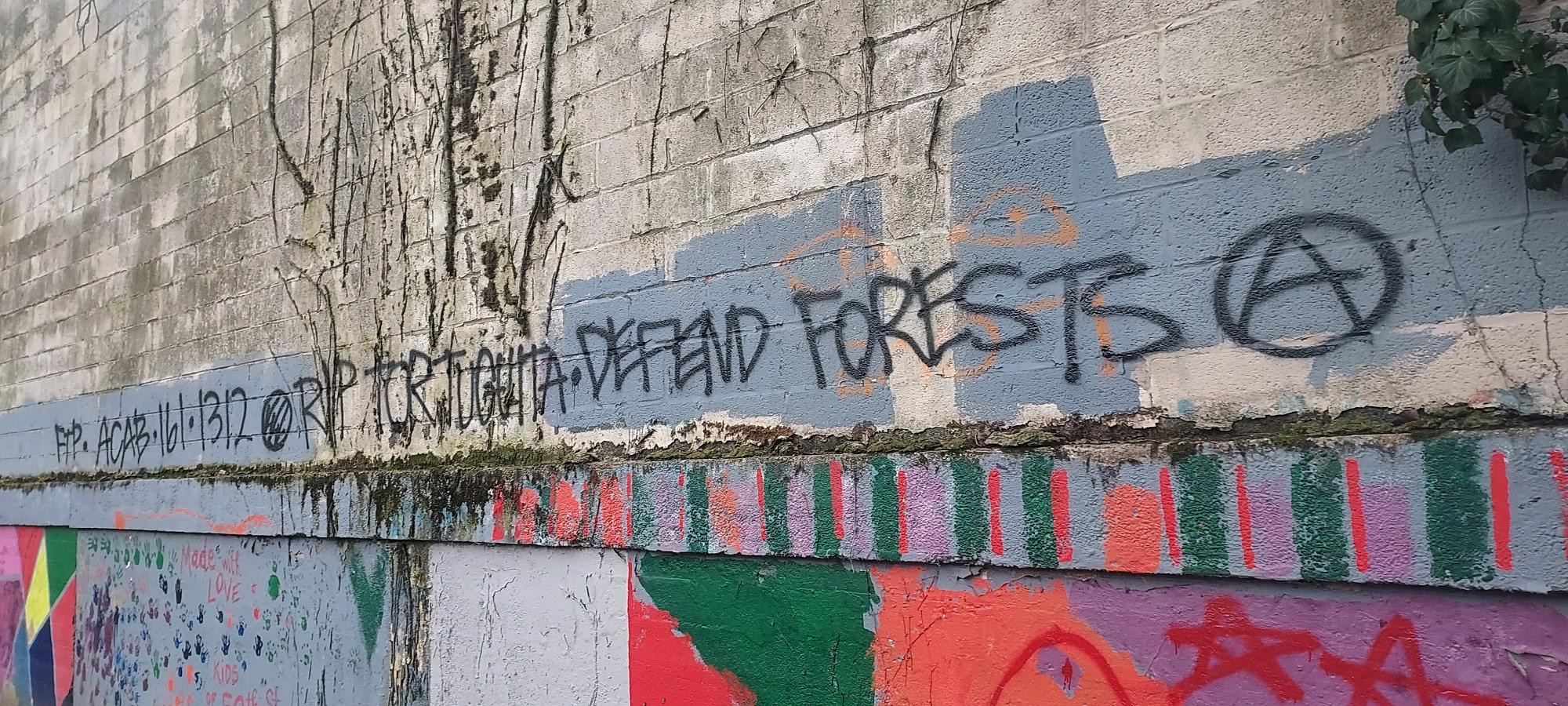
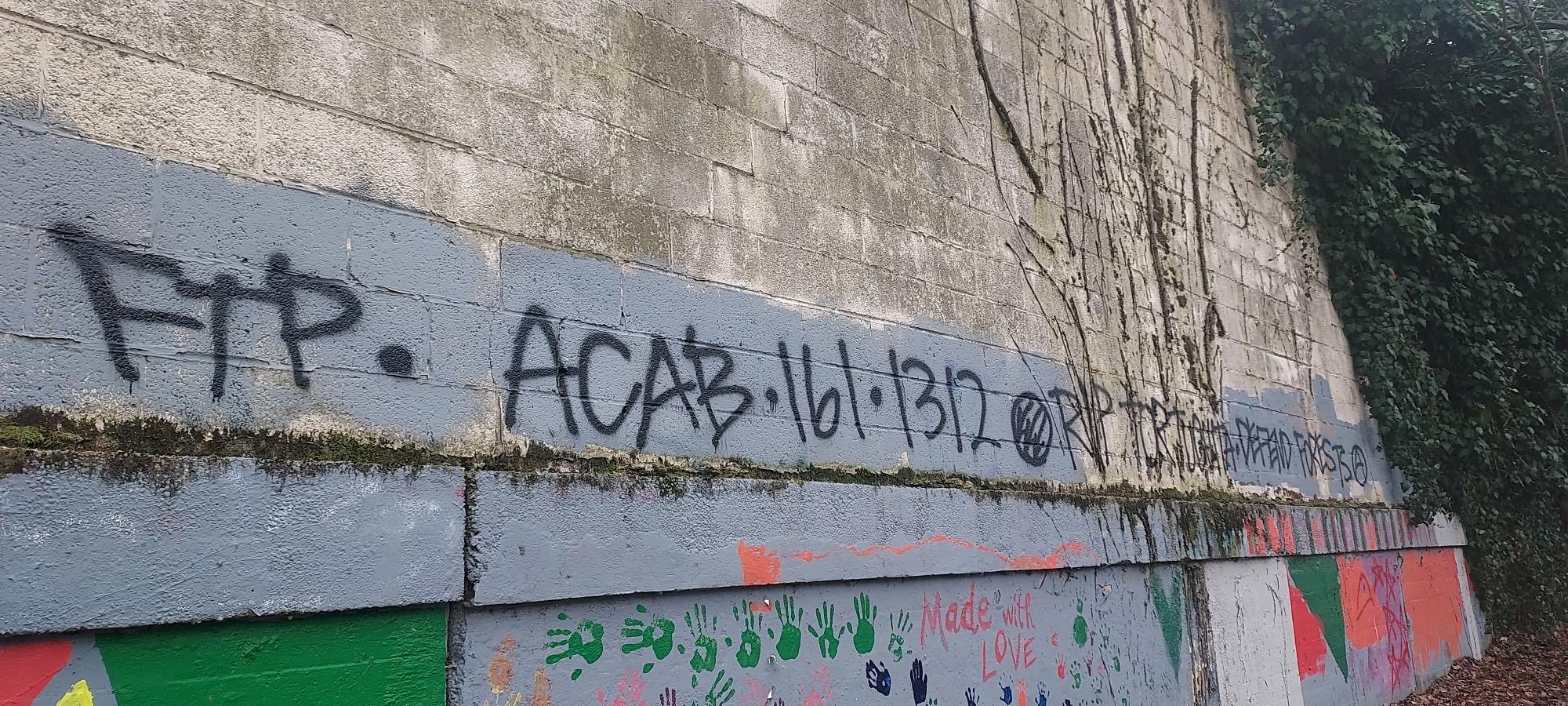
from Twitter

West #Philadelphia earlier tonight: A vigil at a turtle sculpture in Clark Park to remember #Tortuguita, the forest defender killed near #Atlanta. About 70 people joined a vigil and talked about local struggles. One shared a memory of meeting Tort in the forest last year.

from It’s Going Down

Philadelphia, PA
from Jersey Counter-Info
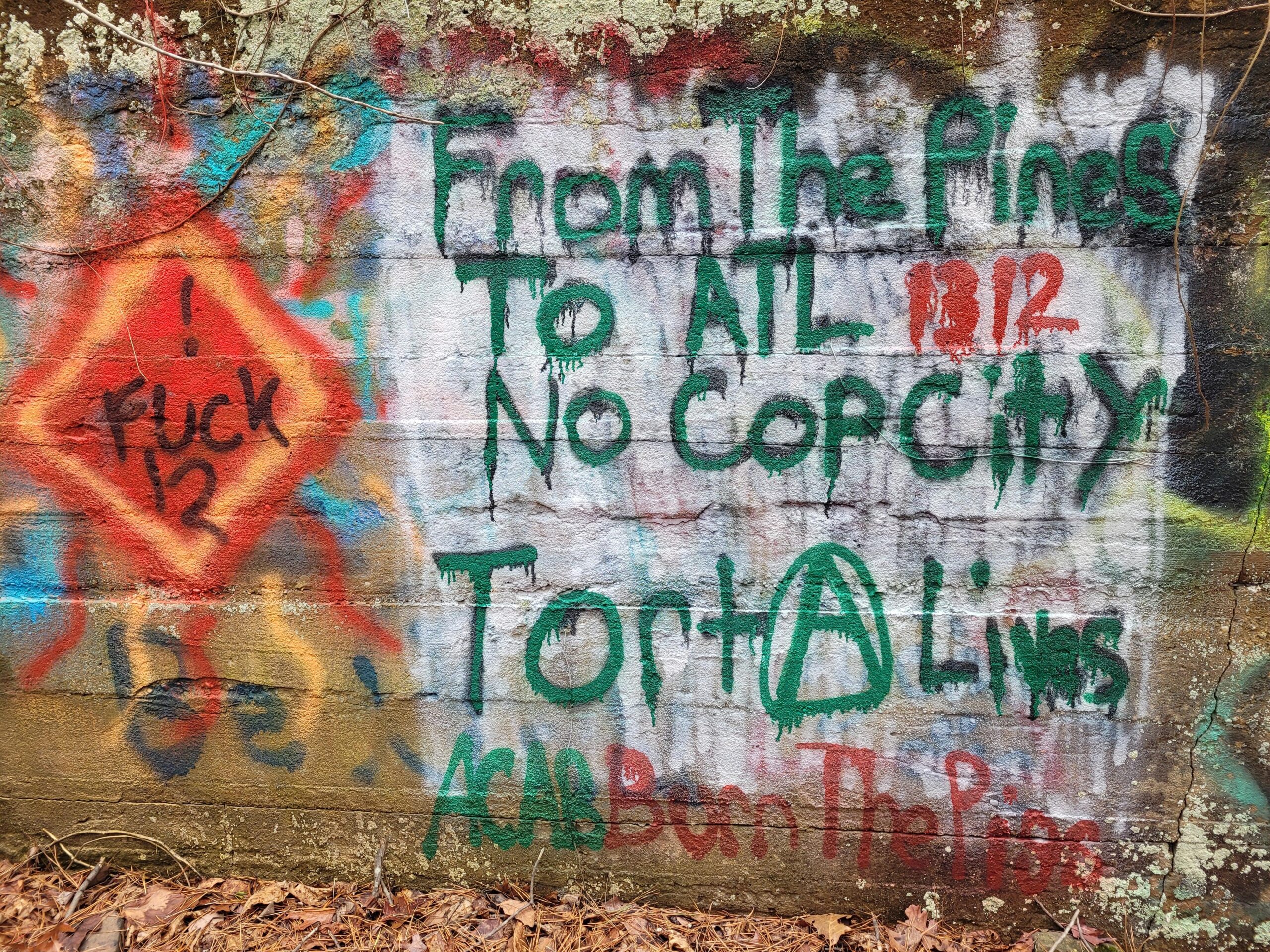
Graffiti placed in the Pinelands of NJ in solidarity with the struggle to Stop Cop City and to Defend the Atlanta Forest and in memory of Tortuguita who was murdered by police while defending the Atlanta Forest.



Submission

Screening of Animal People (2019)
Monday January 9
7PM
Ask here & now zines for location
(IG @hereandnowzines Mastodon ni.hil.ist/@hereandnowzines)
In conjunction with the Weekend of Solidarity to Stop Cop City. Animal People (97mins) is a documentary about animal liberation activists using innovative strategies. Discussion to follow about local land struggles.
from It’s Going Down

[This post only contains information relevant to Philadelphia and the surrounding area, to read the entire article follow the above link.]
Diversity of tactics is a concept that has been used to break the hegemony of non-violence in social movements. The term can be understood as a shared principle that advocates respect and solidarity across different approaches with the aim of breaking down moralistic and ideological divisions. Tactics, however, are often confused with methods, leading to a dangerous misuse of the idea of diversity of tactics to advocate for tolerance of or collaboration with authoritarian, populist, or democratic initiatives.
Since Night Owls focuses on sabotage, which is a tactic, and direct action, which is a method, we want to dive into these ideas and how they might relate to anarchist struggle more broadly. Tactics can be understood as what you do and methods as how you do it. Tactics change according to the moment and the needs of the struggle, whereas methods are stable and well-defined, remaining consistent across contexts, though how methods are understood and developed will vary.
Smashing something or lighting something on fire does not necessarily contribute to the struggle against domination if it is carried out using authoritarian or reformist methods. Pushing forward confrontational tactics while failing to be critical of the methods employed can lead anarchists to enact a sort of “leftism with teeth:” when conflictual efforts are subsumed by dominant political forces and used to grease the wheels of the democratic process. Among other reasons, many anarchists focus on developing autonomous methods of struggle to avoid becoming foot soldiers of the left—diverting a liberatory project into voting with bricks.
On the other hand, reducing the anarchist project to militant tactics can create hierarchies where some tactics are valued above others, instead of understanding how different tactics work together in an ecosystem of actions and ideas. This can lead to the uncritical valorization of militancy for militancy’s sake, fertile ground for the creep of militarism into radical struggles, risking the transformation of a dynamic social conflict into a conflict between isolated militant actors and the state.
Central to anarchism is the method of direct action, which is self-organized by definition. Direct action and sabotage are often used interchangeably, but this is a mistake—many tactics, including sabotage but also those considered “peaceful” such as wheatpasting posters around your neighborhood, can be approached through the method of direct action. The word ‘direct’ here means without mediation; without any intermediary, representative, central committee, union, or other leaders—formal or informal—between you and action. It is a refusal of the logic of democracy; of engaging in dialogue with power, of waiting, of compromise. Tactics such as collaborating with political parties or mass media are incompatible with an anarchist understanding of diversity of tactics: they violate the principle of self-organization, instead reproducing alienation and centralization. By using reformist methods, these tactics foment divisions between actors and spectators, representatives and represented, snuffing out self-organization and the potential for social contagion. Reformist mentalities can often even find their way into action claims, as Let’s Talk About Attack aptly proposes to do away with:
It’s not about bringing a mean company to better intentions, of forcing it to change its bad habits via punitive measures, nor of pressuring an institution to change its mind. […] when we’re talking about, for example, companies that build prisons, high speed train lines, airports, let’s refuse all forms of communication (even the radical ones) with the enemy; let’s refuse all forms of reformism. Better still: we don’t want to spread the logic of reformism, we want to destroy it. The goal is, then, not to convince (by way of damage, material or monetary); the goal is to sabotage and attack the entirety of the project on all terrains. Attack – not to convince, but because we are convinced we don’t want this project. Attacking, not to punish, but to make life harder for the enemy. From the construction companies to the security coordinators and engineers; from the civilian participants to the banks who finance the project.
This column is especially interested in actions that inspire new conceptions of anarchists’ role and potential impact, in which tactics are innovated through creativity and experimentation. In a recent action against a police shooting range in Atlanta’s Weelaunee forest, some “chainsaw-wielding militants’” knocked out the power line feeding the range before going on to destroy the cameras. This action showed creativity both in its choice of target and the tactics used, in an intelligent and effective blow to the facility’s ability to operate. It demonstrates a shift in focus from the mere symbolic facades of power and reminds us that we are not just against Cop City, but the entire institution of policing.
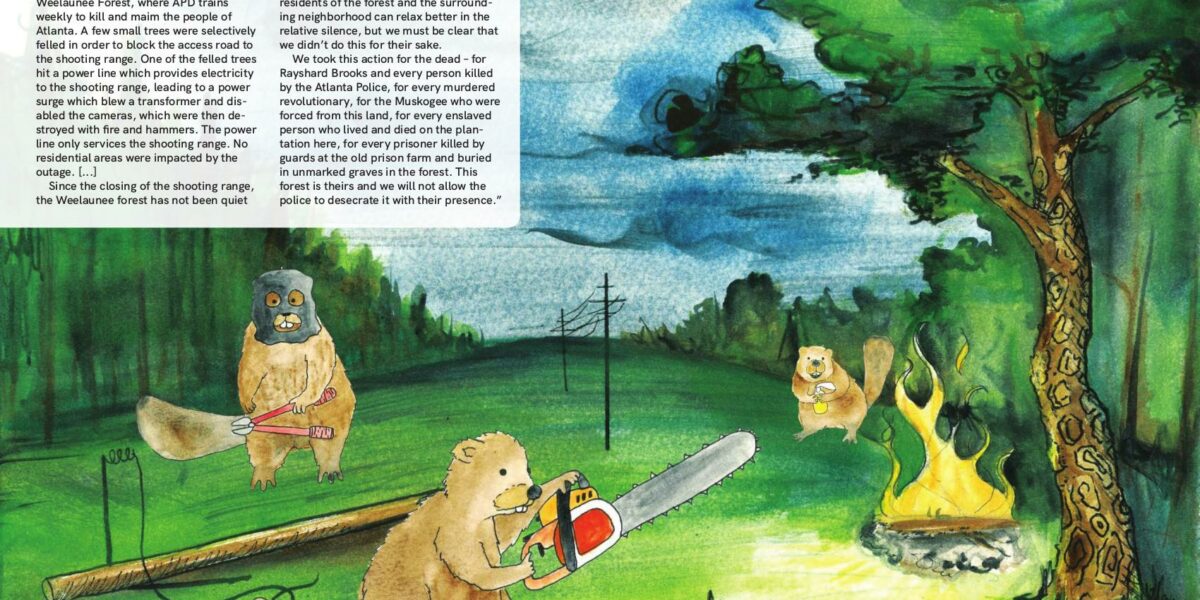
Privileging tactical preferences over shared ethics, goals, and methods can be flimsy ground for collaboration. For example, people who use high-risk tactics but are motivated by a desire to impact public opinion can make unreliable and even dangerous co-conspirators. Many of those who snitched in the Green Scare “revered public opinion about an environmental movement rather than aiming to destroy anti-environmental forces.” More recently, two individuals confessed to having attacked pipelines in a statement to the media, demonstrating a similar desire to impact public opinion—one later became a cooperating witness, while the other, who stayed solid, regretted publishing her identity. People driven by such motivations are liable to change their minds as the tides of “public opinion” inevitably change. Understanding one’s goals and motivations for acting is indispensable, not only for deciding who to take risks with, but also for deciding what to target and how.
This does not mean that you have to be an anarchist to use direct action or to be trustworthy. We are less invested in more people calling themselves anarchists than in the spreading of practices of self-organization and conflict with authority, which were around long before anarchism was named. Our understanding of anarchist methods can grow and deepen by learning from other self-organized struggles and individuals who sabotage domination.
In compiling this column’s list of actions across the so-called United States, we include actions that were claimed with a communique as well as those that were not, with the assumption that there are lessons to be learned from both. The advantages and disadvantages of writing communiques have often been the subject of heated debate among anarchists. Many actions speak for themselves and do not have to be claimed to be understood or to significantly disrupt systems of domination. On the other hand, actions that are not claimed may be harder to find on the internet and so feature less prominently in counter-information projects (including this one), though such websites are rarely engaged with by anyone who’s not themselves an anarchist. In putting together this column, we try to consider the challenge of communicating outside of the anarchist space—which depends on our newspapers, posters, zines, social centers, and physical places of encounter within the struggle.
The torching of three police cars in Pittsburgh this fall was not accompanied by a communique, but the burnt-out shells of the cruisers spoke for themselves and the message could not have been clearer: Fuck the police. We feel it’s important not to speculate about whether this or other actions were carried out by anarchists or not, since that has the potential to aid the police in their investigations. Whatever the motivations of the anonymous one(s) who burned the cars, this action can resonate with anyone who has their own reason to hate and take action against the police.
On the other hand, communiques can also have their own very important place, and all the better when that place is not just the Internet! Although we chose this medium for our column in the interest of reaching a wider audience, we also include a zine version and posters so as to take these ideas and actions off the screen, with its inherent alienation, and spread them through our real world encounters.
This season’s posters feature a communique from occupied Anishinabewaki and Odawa territory (northern Michigan) which claims the arson of heavy machinery at an Enbridge facility. The fight against pipelines and the extractive economy is not restricted to occupations against their construction and is not defeated after they go into the ground. The communique reminds us that the extractive economy, along with the devastation it causes, is all around us, and that it’s possible to fight back.
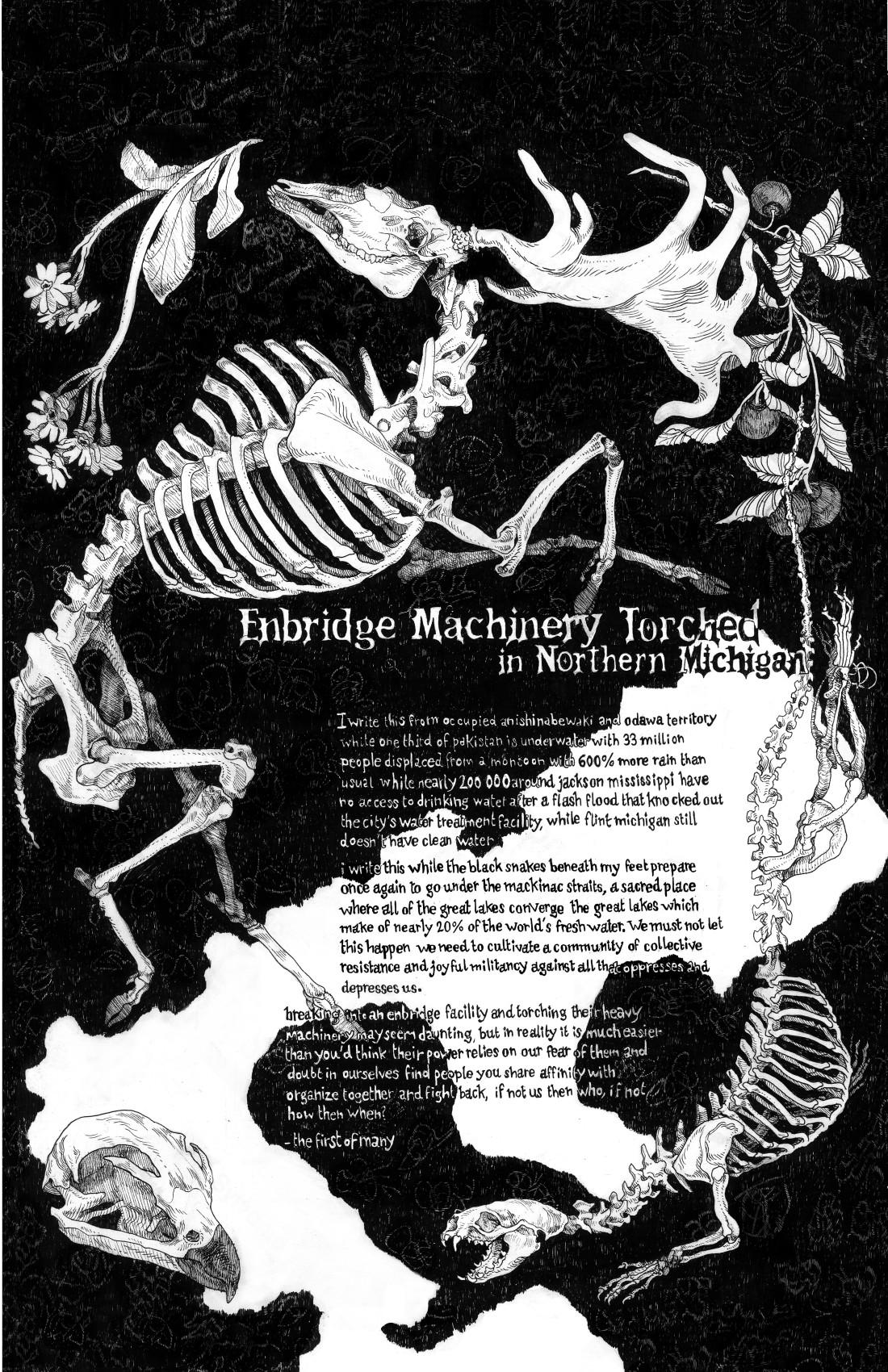
Earth- and animal-liberation focused struggles continued to take major risks to defend land and life over the course of the fall season. Decentralized supporters of the Defend the Atlanta Forest campaign carried out at least ten known direct actions altogether against Cop City, all of them daring and impressive. Meanwhile, we saw a return of Animal Liberation Front fur farm raids, which according to reports released 15,800 mink in total, destroyed vehicles and machinery at one farm, and ultimately forced the closure of Lion Farms, the largest mink exploiter in the U.S. and the target of one of the actions.
As the recent commentary “On Mink Liberation” notes, “Whilst [mink liberation actions] behave like any other animal liberation action—freeing animals from their place of abuse—they are understood easier as a sabotage action.” It’s heartwarming enough to see these individual lives freed from captivity and given a second chance, yet these actors also took care to aim at the mechanisms of the fur industry itself—an industry that’s entirely intertwined with and made possible by the domination of this territory by capitalism and colonization. The most recent mink raid’s communique makes this connection as well, ending: “free all prisoners and give the land back.”
Our last column centered on the significance of our settler colonial context, not only for forest defense and other ecological struggles, but also with regard to how we position ourselves in relation to land, life, and collective survival—with the ultimate objective of destroying the settler colony and returning its territory to the continent’s original inhabitants. This autumn saw a heartening expansion of anti-colonial solidarity actions, from Washington and Oregon to Michigan and Philadelphia. Some of these actions happened in response to solidarity calls, one took place on the colonial holiday Columbus Day, one on Thanksgiving, and another responded in part to the brutal consequences of climate collapse in the Global South. In discussing the need to take apart elements of colonial industry and infrastructure, the communiques attest to the ways in which destructive acts, when paired with anti-colonial methods, can help empower people to move towards self-organization and action, nurture non-hierarchical relationships, and cultivate “communities of collective resistance and joyful militancy.”
Distribution of Night Owls is decentralized—don’t forget to print the column, bring it to infoshops, drop it in newspaper boxes, or just pass it to your friends.
10/12: Philadelphia, Pennsylvania
A colonizer statue was vandalized on Columbus day. “Fighting colonization is a way to nurture a less hierarchical relation with the land and those that live on it.”
11/5: Philadelphia, Pennsylvania (Lenapehoking)
On the Wet’suwet’en day of action, “a small group of Anti-colonial Anarchist settlers in Lenapehoking blockaded a chokepoint of a high frequency railway.”